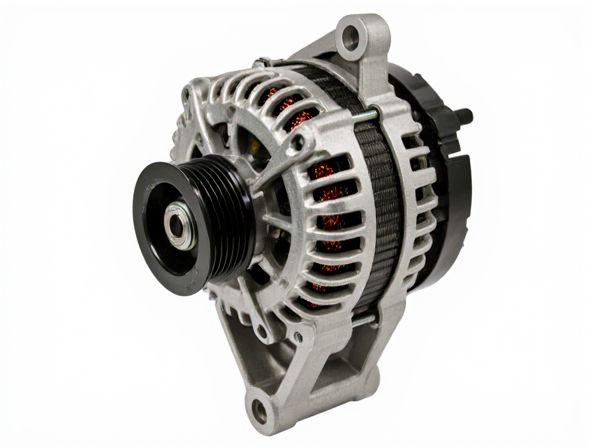
Photo illustration: Remanufactured vs New
Remanufactured products offer a cost-effective alternative to new items by being thoroughly inspected, repaired, and tested to meet original specifications. Choosing remanufactured goods can help you save money while supporting environmental sustainability through reduced waste and resource consumption. High-quality remanufactured options provide reliable performance comparable to new products, making them a smart choice for budget-conscious buyers.
Table of Comparison
| Feature | Remanufactured Alternator | New Alternator |
|---|---|---|
| Cost | Lower price, affordable option | Higher price, premium cost |
| Quality | Tested and rebuilt to OEM standards | Brand new, factory-fresh components |
| Warranty | Limited warranty, typically 6-12 months | Extended warranty, often 1-3 years |
| Lifespan | Good lifespan if from reputable remanufacturer | Longer lifespan with latest technology |
| Environmental Impact | Eco-friendly, reduces waste | Higher manufacturing footprint |
| Availability | May have limited options for rare models | Widely available for most vehicles |
Introduction to Remanufactured vs New Products
Remanufactured products undergo a comprehensive process restoring used items to like-new condition by replacing worn components and testing for quality, offering a cost-effective and environmentally friendly alternative to buying new. New products are manufactured from raw materials and provide the latest technology, full warranty, and guaranteed factory settings but often at a higher price point. Choosing between remanufactured and new depends on budget, sustainability preferences, and performance expectations.
What Does Remanufactured Mean?
Remanufactured products are carefully restored to like-new condition through a detailed process that includes disassembly, cleaning, replacing worn parts, and reassembly, ensuring full functionality and reliability. Unlike used items, remanufactured goods undergo rigorous testing and quality control to meet original equipment manufacturer (OEM) standards. Choosing remanufactured components offers a cost-effective, environmentally friendly alternative to buying new, while maintaining performance and warranty coverage.
Defining Brand New Products
Brand new products are items manufactured entirely from raw materials, ensuring the latest technology, full warranties, and original packaging. These products typically undergo rigorous quality control and comply with current industry standards, offering consumers the most up-to-date features and reliability. Unlike remanufactured goods, brand new items have not been previously used or refurbished.
Key Differences Between Remanufactured and New
Remanufactured products undergo a rigorous process of disassembly, cleaning, repairing, and testing to meet original equipment manufacturer (OEM) standards, making them cost-effective and environmentally friendly alternatives to new items. New products are completely manufactured from raw materials, offering the latest technology and full warranty coverage, but typically come at a higher price point. The key difference lies in the origin and condition, with remanufactured goods combining used components rebuilt to like-new condition and new products being entirely unused and fresh off the production line.
Cost Comparison: Remanufactured vs New
Remanufactured products typically cost 30-50% less than new items, offering substantial savings without sacrificing quality. The lower price stems from reusing core components and reduced material costs while maintaining manufacturer standards. Choosing remanufactured options significantly decreases upfront expenses, making them a cost-effective alternative in industries like automotive, electronics, and machinery.
Quality and Reliability Factors
Remanufactured products undergo rigorous testing and replacement of worn components to meet or exceed original equipment manufacturer (OEM) standards, ensuring high quality and reliability comparable to new items. New products typically offer the latest technology and a full warranty, which can provide greater assurance of performance and durability. Selecting between remanufactured and new depends on balancing cost savings with specific quality requirements and the reliability expectations for the intended use.
Environmental Impact and Sustainability
Remanufactured products significantly reduce environmental impact by conserving raw materials and decreasing waste sent to landfills, lowering carbon emissions compared to producing new items. Sustainable manufacturing processes in remanufacturing extend product life cycles and promote circular economy principles. Choosing remanufactured goods supports resource efficiency and reduces the ecological footprint associated with extraction and production of new materials.
Warranty and Support Considerations
Remanufactured products often come with warranties ranging from 90 days to one year, providing limited but reliable coverage compared to new products that typically offer warranties lasting one to three years with broader support options. Support for remanufactured items may include basic technical assistance and limited replacement policies, whereas new products usually benefit from comprehensive customer service, including extended support plans and return policies. Evaluating warranty length, coverage details, and support quality is crucial when deciding between remanufactured and new purchases to ensure long-term value and protection.
Ideal Use Cases for Each Option
Remanufactured products are ideal for budget-conscious consumers or businesses seeking reliable performance with reduced environmental impact, commonly used in automotive parts, electronics, and industrial machinery where cost efficiency and sustainability matter. New products suit situations requiring the latest technology, full warranty coverage, and maximum lifespan, making them preferable for high-stakes applications like medical equipment, advanced computing devices, or luxury goods. Choosing between remanufactured and new hinges on factors like budget constraints, performance requirements, regulatory standards, and the intended lifecycle of the product.
How to Choose: Remanufactured or New?
Choosing between remanufactured and new products depends on budget, environmental impact, and quality assurance. Remanufactured items offer cost savings and sustainability benefits while often coming with warranties that guarantee performance comparable to new counterparts. New products provide the latest technology and full manufacturer support but at a higher price point, making consumer priorities essential in the decision-making process.
 caratoz.com
caratoz.com